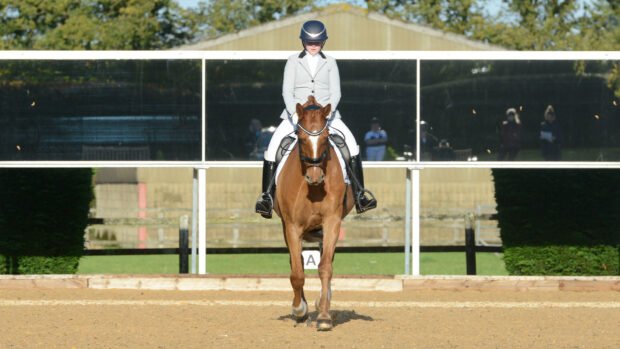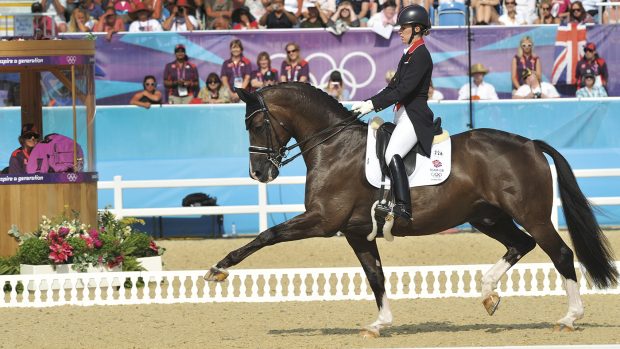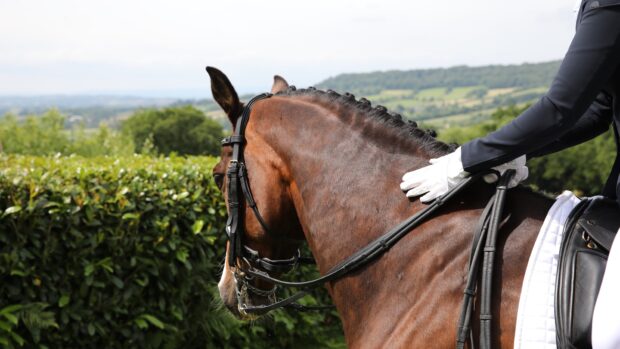When competing at or training for dressage, whether you have a young or established horse, the overall aim is to use the scales of training to work your way up through the dressage levels.
Each of the levels of dressage features a number of different dressage tests. Each test is unique, but tests within the same level share the same movements. As you progress through the levels, tests will include movements and paces learnt at previous levels as well as the new ones that are introduced at each stage.
Many riders compete at one level, but train at a higher level at home. This ensures that the horse and rider are confident with the movements being ridden in competition, giving the partnership the opportunity to demonstrate their skills to the best of their ability.
Levels of dressage competition in Britain
The sport in Britain is governed by British Dressage, who are responsible for the provision and regulation of competition, while international competitions are run by the FEI. British Dressage host two major championships annually at each level, which are known as the Nationals (prelim to grand prix) and the Winters (prelim to inter I), as well as many regional championships, festivals and other team competitions.
The British dressage levels are as follows…
Introductory
“Intro” is the first level and includes halt, plus simple walk and trot movements, including free walk on a long rein, trot-walk-trot transitions, 10m circles at walk, half 10m circles at trot, 20m circles and three-loop serpentines at trot and allowing the horse to stretch in trot. The tests are ridden in a 20×40 arena and designed to show that horse and rider are beginning their training on correct lines, with an emphasis on rhythm, suppleness and contact.
Preliminary
Canter is introduced at “prelim” level. You should expect to ride 20m circles in canter, 15m circles in trot as well as stretching in trot, plus 10m half circles at walk. All of the work requires the partnership to show they are establishing rhythm, suppleness and a good contact. Tests at this level can be set in 20×40 and 20×60 arenas.
Novice
Novice tests introduce some medium trot and medium canter steps, but the quality of the steps is prioritised over the number of steps shown. Novice also sees the introduction of counter canter and progressive transitions from walk to canter when a few strides of trot may be shown. In trot, circles of 10m or larger as well as serpentines, are required. Canter circles can be 15m or larger. Giving and retaking of the reins, 10m loops in trot, and changes of canter lead through trot can be expected. The scales of training should be becoming more established, including rhythm, suppleness, contact, impulsion, straightness and the start of collection shown through the downward transitions.
Elementary
This level is the first that requires the early stages of collection to be shown in the form of sufficient engagement of the hindquarters to carry out the movements with ease and balance. Elementary is the first level to introduce lateral work with the leg yield and shoulder-in in trot. You’ll also be required to ride collected trot, collected canter, stretching in canter and simple changes. Canter circles can be down to 10m. In the simple change of leg, the downward transition may be progressive, but walk to canter should be direct with the walk steps clearly shown. Rein back is first seen at elementary level. Double bridles are first allowed at this level, although they are not compulsory.
Medium
Once at medium level all of the scales of training should be established, with the horse showing suppleness, elasticity and impulsion to be able to collect and extend its paces on request. The horse should show a marked degree of self-carriage, lightness and cadence. Extended trot and walk pirouettes are first seen at medium. More lateral work is required including shoulder-in, travers, and half pass at trot and canter are also introduced. Medium is the first level at which sitting trot is mandatory, although you can rise for medium and extended trot movements.
Advanced medium
Expect to see single flying changes at advanced medium, and the introduction of 8m circles (or voltes) that are ridden at trot and canter. Sitting trot is required for all trotwork at this level.
Advanced
This level requires you to ride canter half circles with the quarters in as a stepping stone towards canter pirouettes, plus four- and five-time tempi changes. At advanced level you have the option to begin wearing a tail coat instead of a short competition jacket. All test are in the 20×60 arena.
Prix st georges
Often shortened to PSG, this level marks the start of international competition. It introduces the half canter pirouette, three-time tempi changes and simple changes of leg after a canter half pass (from counter canter to true canter).
Intermediate I
At “inter I”, expect to ride two-time tempi changes and a full canter pirouette.
Intermediate II
“Inter II” introduces one-time tempi changes, flying changes after a half pass, piaffe and passage.
Grand prix
This is the highest level of dressage and is regarded as the ultimate test. This is the level you’ll see at the Olympics, World Championships and FEI World Cup competitions.
US dressage levels
National level dressage competition is governed by the United States Equestrian Federation. There are five levels of national tests, which are followed by international levels.
Training
Comparable to prelim in Britain, at this level competitors should show the horse has true natural paces, is obedient, calm and relaxed. The USEF states that the level should “introduce the sport of dressage, confirming that the horse and rider are beginning to develop an understanding of correct dressage basics. The horse should be ridden freely forward in a steady tempo and clear rhythm, accepting contact with the bit. An understanding of test accuracy and geometry should be demonstrated.”
First
Comparable to British novice level, at first level the horse should now be able to show some lengthened strides in the trot and canter and perform some 10 or 15 metre circles in trot and canter. The USEF states that level aims to ensure “the horse demonstrates correct basics, by showing suppleness both laterally and longitudinally, moving freely forward in a clear rhythm with a steady tempo, and readily accepting contact with the bit. Correct geometry and lines of travel should be shown.”
Second
This level, which is similar to the British elementary level, introduces collected trot and canter, counter canter and rein-back. According to the USEF, this level “confirms that the horse demonstrates correct basics, and now begins to accept more weight on the hindquarters as the collected and medium gaits develop. A greater degree of straightness, suppleness, throughness, and balance are required to perform the movements with ease and self-carriage.”
Third
Comparable to medium and advanced medium, the movements at this level should be executed without tension. It introduces the walk half pirouettes and flying changes. The level, according to the USEF, “confirms that the horse demonstrates correct basics while maintaining consistent uphill balance and self-carriage. Increased engagement facilitates clear differences in collected, medium, and extended gaits with well-defined, balanced transitions. Movements should be accomplished with harmony and ease due to the increased balance and collection. The horse must demonstrate a greater degree of throughness, suppleness, straightness, and bending.”
Fourth
At this level, which is similar to advanced level in Britain, half and full pirouettes are required in canter, and counter-canter and four-time changes are also expected. The USEF says that this level shows that the horse “has developed sufficient throughness, suppleness, balance, and impulsion to perform with ease the exercises at this medium level of difficulty. The horse has established consistent self-carriage and lightness through improved connection, engagement, and collection. The movements and transitions are performed with greater straightness, impulsion, and cadence.”
You might also like:

Dress for success with Horse & Hound’s what to wear guide for dressage competitions

Fancy trying affiliated dressage, but not quite sure where to start? You need to read this…

The scales of training explained for horse riders of all levels

What is lateral work, and how can it help my horse?

Subscribe to Horse & Hound magazine today – and enjoy unlimited website access all year round
Horse & Hound magazine, out every Thursday, is packed with all the latest news and reports, as well as interviews, specials, nostalgia, vet and training advice. Find how you can enjoy the magazine delivered to your door every week, plus options to upgrade your subscription to access our online service that brings you breaking news and reports as well as other benefits.





